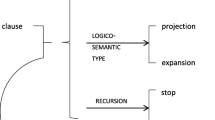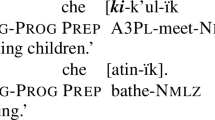Conclusion
Section 1 described this study as representing the convergence of two seemingly unrelated lines of research. One of these focused on the behavior of embedded 3s in Romance and other languages. The second concerned counterexamples to the ergative analysis provided by languages which did not fit the Romance pattern. A resolution of each of the problems in both these areas is possible through the Inheritance Principle and the recognition of the role of the SUL in the clause union construction. In languages with French-type clause union the failure of certain complement 3s to behave as 3s in the union clause has been shown to follow from their chômage, which is in turn predictable from the interaction of the Inheritance Principle and the SUL. The variation across languages in the clause union construction is restricted to the single parameter of mapping embedded 1s into matrix Objects. Once this mapping has been specified, the remaining properties of the clause union construction, including the distribution of chômeurs, are completely determined by the interaction of the Inheritance Principle and the SUL. Note that the collapsing view of clause union is crucial for our analysis, especially for the case in which an embedded nominal is a chômeur at the union stratum. Our results in this area could not be attained under a conception of the clause union construction in which it is biclausal at all levels, since under such an analysis the SUL would not be relevant.
With respect to all GRs except the 1-relation our proposal is extremely restrictive. For example, in a language where no embedded 1s are union stratum 3s we claim that it is impossible for any embedded final 3s to be union stratum Chômeurs. Conversely, in a language in which some embedded transitive 1s are union stratum 3s, it is impossible for all embedded final 2s to be union stratum Chômeurs.
Our system allows for considerable variation, however, in the mapping of embedded 1s into matrix Objects. We do not yet have sufficient empirical evidence bearing on the issue of limiting these possibilities to offer any proposal more restricted than our union parameter (21). Available evidence suggests that the number of attested realizations of (21) will be quite small. As an example, we know of no language in which all embedded 1s are union stratum 3s, an instantiation allowed by (21), though we do not have as yet any motivated principle for excluding this or other possibilities. However, it is clear what type of structure should occur if in some language the embedded 1 happened not to fall under some language-particular union rule. In that case, the embedded 1 would follow the dictates of the Inheritance Principle, clashing with the matrix 1. This conflict would then be resolved through the chômage of the embedded 1 in the clause union construction. We have not been able to discover any clear example of such a language (see Rosen, 1983).Footnote 1
(i) subject - direct object - indirect object - other oblique constituent
Comrie suggests that in the clause union construction the embédded 1 is shifted to the right along this hierarchy to the first open position. In some respects, our view of clause union is closer to Comrie's than to the ergative analysis of Perlmutter and Postal. However, the precise nature of his claims is sufficiently difficult to ascertain to make comparison difficult.
Similar content being viewed by others
Notes
The question of how many patterns exist for the clause union construction is addressed in Comrie (1976), where the hierarchy of syntactic positions in (i) is claimed to be relevant for characterizing the causative construction.
References
Aissen, Judith: 1974a, The Syntax of Causative Constructions, Ph.D. dissertation, Harvard University.
—: 1974b, ‘Verb Raising’, Linguistic Inquiry 5, 325–366.
--: 1983, ‘Indirect Object Advancement in Tzotzil’, in D. Perlmutter (ed.), pp. 272–302.
Aissen, Judith and David Perlmutter: 1976, ‘Clause Reduction in Spanish’, BLS, 2, 1–30, revised version in D. Perlmutter (ed.), pp. 360–404.
Bell, Sarah: 1976, Cebuano Subjects in Two Frameworks, Ph.D. dissertation, MIT, distributed by Indiana University Linguistics Club, Bloomington.
--: 1983, ‘Advancements and Ascensions in Cebuano’, in D. Perlmutter (ed.), pp. 143–218.
Chung, Sandra: 1982, ‘Unbounded Dependencies in Chamorro Grammar’, Linguistic Inquiry 13, 39–77.
Cole, Peter: 1976, ‘A Causative Construction in Modern Hebrew: Theoretical Implications’, in P. Cole (ed.), Studies in Modern Hebrew Syntax and Semantics, North-Holland, Amsterdam.
Cole, Peter and Shikaripur Sridhar: 1977, ‘Clause Union and Relational Grammar: Evidence from Hebrew and Kannada’, Linguistic Inquiry 8, 700–713.
Comrie, Bernard: 1976, ‘The Syntax of Causative Constructions: Cross-Language Similarities and Divergences’, in M. Shibatani (ed.), pp. 261–312.
Crain, Catherine: 1979, ‘Advancement and Ascension to Direct Object in Chamorro’, Linguistic Notes from La Jolla 6, University of California, San Diego.
Davies, William: 1984, ‘Antipassive: Choctaw Evidence for a Universal Characterization’, in D. Perlmutter and C. Rosen (eds.), pp. 331–376.
—: 1986, Choctaw Clause Structure, D. Reidel, Dordrecht.
Fauconnier, Gilles: 1983, ‘Generalized Union’, Communication and Cognition 16, 3–37.
Frantz, Donald: 1977, ‘Downstairs Transitivity in Causative Clause Unions’, Workpapers of the Summer Institute of Linguistics, University of North Dakota, Vol. 21, 77–87.
Gibson, Jeanne: 1980, Clause Union in Chamorro and in Universal Grammar, Ph.D. dissertation, University of California, San Diego.
Harris, Alice: 1981, Georgian Syntax: A Study in Relational Grammar, Cambridge University Press, Cambridge, Mass.
—: 1982, ‘Georgian and the Unaccusative Hypothesis’, Language 58, 290–306.
Kayne, Richard: 1975, French Syntax: The Transformational Cycle, MIT Press, Cambridge, Mass.
Legendre, Géraldine: 1986, ‘Object Raising in French: A Unified Account’, Natural Language and Linguistic Theory 4, 137–183.
Olié, Annie: 1984, ‘L'Hypothèse de L'Inaccusatif en Français’, Linguisticae Investigationes 8, 363–401.
Perlmutter, David: 1978, ‘Impersonal Passives and the Unaccusative Hypothesis’, BLS 4, 157–189.
—: 1983a, ‘Personal vs. Impersonal Constructions’, Natural Language and Linguistic Theory 1, 141–200.
— (ed.): 1983b, Studies in Relational Grammar 1, The University of Chicago Press, Chicago.
Perlmutter, David and Paul Postal: 1974, ‘Lectures on Relational Grammar’ unpublished notes, Summer Linguistics Institute of the LSA, University of Massachusetts, Amherst.
—: 1977, ‘Toward a Universal Characterization of Passivization’, BLS 3, 394–417, revised version in D. Perlmutter (ed.), pp. 3–29.
--: 1983a, ‘The Relational Succession Law’, in D. Perlmutter (ed.), pp. 30–80.
--: 1983b, ‘Some Proposed Laws of Basic Clause Structure’, in D. Perlmutter (ed.), pp. 81–128.
--: 1984, ‘The 1-Advancement Exclusiveness Law’, in D. Perlmutter and C. Rosen (eds.), pp. 81–125.
Perlmutter, David and Carol Rosen (eds.): 1984, Studies in Relational Grammar 2, The University of Chicago Press, Chicago.
Postal, Paul: 1977, ‘Antipassive in French’, Linguisticae Investigationes 1, 333–374.
—: 1981, ‘A Failed Analysis of the French Cohesive Infinitive Construction’, Linguistic Analysis 8, 281–323.
—: 1982, ‘Some Arc Pair Grammar Descriptions’, in P. Jacobson and G. Pullum (eds.), The Nature of Syntactic Representation, D. Reidel, Dordrecht, pp. 341–425.
—: 1983a, ‘On Characterizing French Grammatical Structure’, Linguistic Analysis, 11, 361–417.
—: 1983b, ‘French Indirect Object Cliticization and Noncliticization’, unpublished paper, Thomas J. Watson Research Center, IBM, Yorktown Heights, New York.
—: 1985, ‘French Indirect Object Cliticization and SSC/BT’, Linguistic Analysis 14, 111–172.
Quicoli, António-Carlos: 1980, ‘Clitic Movement in French Causatives’, Linguistic Analysis 6, 131–185.
Radford, Andrew: 1978, ‘Agentive Causatives in Romance: Accessibility versus Passivization’, Journal of Linguistics 14, 35–58.
Rosen, Carol: 1981, The Relational Structure of Reflexive Clauses: Evidence from Italian, Ph.D. dissertation, Harvard University.
—: 1983, ‘Universals of Clause Union: A Co-Proposal to the Gibson-Raposo Typology’, CLS 19, 338–352.
--: 1984, ‘The Interface between Semantic Roles and Initial Grammatical Relations’, in D. Perlmutter and C. Rosen (eds.), pp. 38–80.
Rouveret, Alain and Jean-Roger Vergnaud: 1980, ‘Specifying Reference to the Subject: French Causatives and Conditions on Representations’, Linguistic Inquiry 11, 97–202.
Seiler, Wolf: 1978, ‘The Modalis Case in Iñupiat’, Workpapers of the Summer Institute of Linguistics, University of North Dakota, Vol. 21, pp. 71–85.
Shibatani, Masayoshi (ed): 1976, Syntax and Semantics 6: The Grammar of Causative Constructions, Academic Press, New York.
Suzuki, Kyoko: 1985, A Relational Analysis of Japanese Causative Constructions, M.A. dissertation, Cornell University.
Williamson, Janis: 1979, ‘Patient Marking in Lakhota and the Unaccusative Hypothesis’, CLS 15, 353–365.
Zimmer, Karl: 1976, ‘Some Constraints on Turkish Causativization’, in M. Shibatani (ed.), pp. 399–412.
Author information
Authors and Affiliations
Additional information
We thank Sandy Chung, Bill Davies, Gilles Fauconnier, Janis Williamson and anonymous NLLT reviewers for discussion and/or comments. We are especially indebted to David Perlmutter and Paul Postal for providing us with detailed and extensive comments on both style and content. The usual disclaimers apply. We also thank Annie Olié for helping us with her native intuitions on French. This work was partly supported by the following grants and entities: NSF Grant BNS 78-13018, NSF Grant BNS 78-17498, Instituto Nacional de Investigação Científica, Lisbon, Portugal, and the Fulbright-Hayes Foundation.
Rights and permissions
About this article
Cite this article
Gibson, J., Raposo, E. Clause union, the stratal uniqueness law and the chômeur relation. Nat Lang Linguist Theory 4, 295–331 (1986). https://doi.org/10.1007/BF00133372
Received:
Revised:
Issue Date:
DOI: https://doi.org/10.1007/BF00133372




